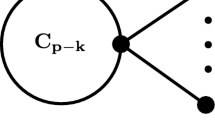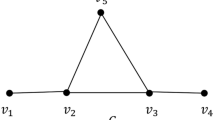Abstract
A forest is the clique complex of a strongly chordal graph and a quasi-forest is the clique complex of a chordal graph. Kruskal-Katona type theorems for forests, quasi-forests, pure forests and pure quasi-forests will be presented.
Similar content being viewed by others
References
W. Bruns and J. Herzog: Cohen-Macaulay rings, Revised Edition, Cambridge University Press, 1996.
A. Björner: The unimodality conjecture for convex polytopes, Bull. Amer. Math. Soc. 4 (1981), 187–188.
R. Charney and M. Davis: The Euler characteristic of a nonpositively curved, piecewise Euclidean manifold; Pacific J. Math. 171 (1995), 117–137.
J. Eckhoff: Über kombinatorisch-geometrische Eigenschaften von Komplexen und Familien konvexer Mengen, J. Reine Angew. Math. 313 (1980), 171–188.
S. Faridi: Cohen-Macaulay properties of square-free monomial ideals, J. Combin. Theory, Ser. A 109 (2005), 299–329.
D. Ferrarello and R. Fröberg: The Hilbert series of the clique complex, Graphs Combin. 21 (2005), 401–405.
A. Frohmader: Face vectors of flag complexes, arXiv:math/0605673, preprint.
S. R. Gal: Real root conjecture fails for five-and higher-dimensional spheres, Discrete Comput. Geom. 34 (2005), 269–284.
J. Herzog, T. Hibi and X. Zheng: Dirac’s theorem on chordal graphs and Alexander duality, European J. Combin. 25 (2004), 949–960.
T. Hibi: What can be said about pure O-sequences?, J. Combin. Theory, Ser. A 50 (1989), 319–322.
T. Hibi: Algebraic Combinatorics on Convex Polytopes, Carslaw Publications, Glebe, N.S.W., Australia, 1992.
G. Kalai: Characterization of f-vectors of families of convex sets in ℝd, Part I: Necessity of Eckhoff’s conditions; Israel J. Math. 48 (1984), 175–195.
G. Kalai: Characterization of f-vectors of families of convex sets in ℝd, Part II: Sufficiency of Eckhoff’s conditions; J. Combin. Theory, Ser. A 41 (1986), 167–188.
T. A. McKee and F. R. McMorris: Topics in Intersection Graph Theory, Society for Industrial and Applied Mathematics (SIAM), Philadelphia, PA, 1999.
P. Renteln: The Hilbert series of the face ring of a flag complex, Graphs Combin. 18 (2002), 605–619.
R. Stanley: Combinatorics and Commutative Algebra, Second Edition, Birkhäuser, 1995.
X. Zheng: Resolutions of Facet Ideals, Comm. Algebra 32 (2004), 2301–2324.
Author information
Authors and Affiliations
Corresponding author
Rights and permissions
About this article
Cite this article
Herzog, J., Murai, S., Zheng, X. et al. Kruskal-Katona type theorems for clique complexes arising from chordal and strongly chordal graphs. Combinatorica 28, 315–323 (2008). https://doi.org/10.1007/s00493-008-2319-8
Received:
Published:
Issue Date:
DOI: https://doi.org/10.1007/s00493-008-2319-8




